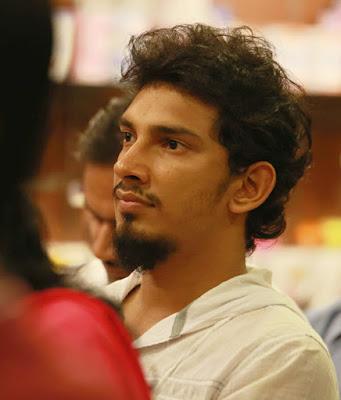As one of my favorite Czech Author, Milan Kundera once said that every act of creativity, writing or novel should have a purpose. I had decided to write my story in year 1987, when I first visited Rishikesh, finished writing all three parts of "The Monk Key" in 2010 Nov. But still had no reason to get it published other than my ego, I.e. to get to be known as an author, which was actually not on my priority list. But last year, one day I asked my son, have you read Bhagwat Gita and he said, no - what’s the point of reading it. This gave me a purpose, i.e. to make our Vedic / Upanishadic / Poranic scriptures come out of obscure depths of dogmatic beliefs and rituals and become main stream and interesting for young generation. This book "Songs of the Mist" and "The Monk Key" series is my one small step towards that goal.
You see, our conscious mind works on only two things - logic and language. And our ancient books and scriptures are treasure troves of both Language as well as knowledge and the extremely deep thought processes. Reading these ancient books can easily ignite a spark a new idea, a new search for meaning in your mind, specially young minds. Yes there are things written in these books that usually don’t go with modern and prevalent scientific thoughts. But the fact is that some people cherry-pick only the negative things about our culture and heritage, and in the process creating a narrative, which is not actually in the sync with the grand reality of our heritage and culture. This ultimately has created a bias against our vedic heritage and culture and alienated young generation. This saddens me to a great extent and with this post I am trying to put things in certain perspective, with hope that it will inspire you to reach out to our heritage and culture.
Almost 3000 years ago, Pythagoras came to India, (Albert Burk in his book Das Apstamba Sulba Sutra 1901 says he came to Kanchipuram) to learn from Indian sages, masters and went back to his city. Apart from the Pythagoras theorem that he is famous for, which is now proven to be the direct takeaway from Shulabha Strotra, he also took our methods of teaching, which was famous at the time. - The Gurukul system of learning. The alumni were the likes of Socrates, Plato, Aristotle.
 |
| Image curtsy Wikipedia |
Let me tell you another story, which I have talked about in my blog post earlier discussing the Big Bang (Click here to read). Lemaitre - An ordained priest in 1931 observed the night sky over the years and realised that the nebulae’s he was observing are going farther away. He then proposed that the Universe must be expanding. Then as he retraced this expansion back in time as thought experiment and proposed a theory that as the Universe in the past must have started from a single point. In a BBC interview in 1949, George Gamow another scientist, gave this theory a name - The Big Bang Theory. In 1970, Stephen Hawking and his colleagues proved mathematically that the Universe indeed started from a single point with the Big Bang.
Now the reason I am telling you this story is that almost 3K years ago, in Mandukya Upanishad, it is also said that the Universe was formed from a point with the Pranava Naad which literally means A deep Sound, and if I may paraphrase - from the Big Bang. But if we go out and say this to a scientist, they will laugh. Though this is exactly what the priest Lemaitre proposed in 1930s too. Why?
Because some one took Georges Lemaitre’s words seriously and did continuous research over decades and finally Stephen Hawkins proved it. But unfortunately in India, we don’t do it. We don’t take the thought experiments of our ancient sages to its logical conclusion by research and experiments. Almost 3K years ago we had abandoned the experimental part and only took forward the ritualistic part of our Vedic culture. I feel sad about it.
But slowly things are changing now. There are people still working on those obscure knowledge somehow or the other to make it acceptable to the world. Yoga is one such example of our knowledge being embraced by the world now.
There are people who do get inspired by those ancient shloka, for example a young mathematician of Indian origin in USA- Manjul Bhargava. He is a fields medal winner - which is considered to be a noble prize for mathematics. His grand father in Rajasthan gave him a set of ancient shloka’s. The Fibonacci sequence embedded in the shloka triggered his curiosity and he developed a method that won him his PhD in an US University too.
And I am happy that there are people like Manjul Bhargava from USA, and still more closer to us in Chennai cool people like my friends here, the youth icon and Singer Blaaze and a great Krishna Bhakta, Painter and famous Cartoonist of Hindu Sh. Keshav and music director Paul, with whom I am trying to bring out Songs of the Monk from my book. When I hear them collaborate and sing ancient Shloka’s, I feel that all is still not lost.
__
Shashi
ॐ नमः शिवाय












































